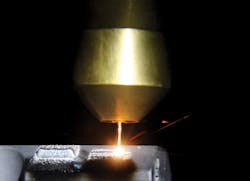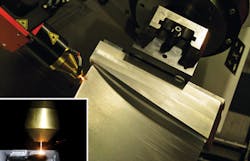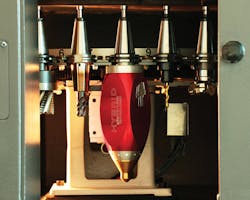Hybrid CNCs expand additive manufacturing
Method enables laser processing flexibility in a single setup
JASON JONES
Advances in lasers and laser beam delivery have been a key enabler for 3D printing since its inception in the 1980s. The hallmark application of 3D printing is the production of prototypes directly from computer models, which is why the field was known as "rapid prototyping" for many years.
Continued development in several areas, including, notably, the advent of high-power solid-state lasers, has enabled 3D printers to produce parts using a wider variety of materials, now including metal. This relatively new technical capability is facilitating the expansion of business opportunities for 3D printing—allowing small- to medium-volume manufacturing of end-use parts, many of which are made from metal. Indeed, the average cost of 3D printers for metal—which is currently around a half-million dollars—would be difficult to justify for prototypes only, yet is viable for high-value, high-complexity production parts. The expanding applicability of 3D printing has led to the rebranding of this family of technologies as additive manufacturing (AM), which shifts away from any one specific application to instead emphasize its defining working principle.
From isolation to integration
With the adoption of AM for industrial manufacturing, especially in metals, the need for downstream part processing has intensified. In particular, metal parts almost always require some finishing steps, most often machining, polishing, or grinding (FIGURE 1).
Since the early years of AM development were driven from a prototyping-oriented focus, self-contained machine architectures dominate the marketplace. This architecture is ideal for prototype production in a design department, but is not optimal for manufacturing when downstream operations are required. In particular, self-contained architectures historically have obliged manual part cleanup and manual transfer to downstream operations.
Despite commercial success and unique technical capabilities, laser-based AM systems are not yet able to produce parts with the accuracy and surface finish of CNC machining. However, recognizing the need for the geometry and material freedom afforded by AM, and the precision of CNC machining, the industry has become highly interested in hybrid combinations of these two machines. This is a definitive step in the development path of AM, shifting away from the isolation of self-contained architecture to integration into complementary manufacturing equipment.
From research to mainstream CNC
Hybrid combinations of additive and subtractive manufacturing techniques have a two-decade history of use in research environments, but-despite promising benefits—have only experienced modest commercial adoption until recently [1]. The first commercial hybrid offering began as an academic/industry research project in Japan in the late 1990s and is a specialist machine tool that combines laser-based powder bed fusion with CNC, now known as the LUMEX Avance-25 by Matsuura [2].
Also, about eight years ago, academic-industry research collaboration set out to make the shift between adding and removing metal as easy as a tool change. The result was the first hybrid offering suitable for mainstream CNC machines, which adds laser cladding (a type of directed energy deposition according to ASTM F42) [3] to machine tools (FIGURE 2). This system was first demonstrated in 2012, and is now known as the AMBIT tool changeable laser cladding system by Hybrid Manufacturing Technologies, which can upgrade new and used CNC machines into industrial 3D printers for metal.
The system can be retrofitted onto existing CNC machines or be fully integrated with additional functionality into new CNC machines, such as the Hamuel HSTM 1000, Mazak INTEGREX i-400 AM, and the Elb-Schliff millGRIND. By using mainstream CNC machines as a platform, this innovation represents a new way to adopt AM and was named "the premiere example of advancement in additive processes and applications" as the inaugural winner of the International Additive Manufacturing Award (IAMA) in 2015.
The core strength of this hybrid process is the ability to shorten 3D print time of metal parts by printing at a coarser resolution to a "near-net" shape and then relying on post-print machining to achieve the desired surface finish and accuracy. Early demonstrations of this capability have included build-up of features, hard facing onto existing parts, and all-in-one repair of blades and impellers, including in-process inspection and finish machining of restored metal surfaces in a single setup. The hybrid repair process was first developed for Cummins turbocharger impellers [4] and then adopted by a leader in the power generation sector for blade repair (FIGURE 3).
Switch from machining to cladding
Patent-pending AMBIT laser-based metal deposition heads are stored in the tool magazine and are loaded into a milling spindle using the standard tool changer. Once loaded into the spindle, a supply unit, fitted to the spindle, docks with a head and delivers laser energy and feedstock material to enable cladding of non-reactive metal powders onto parts. It is controlled by the same CNC controller used for subtractive tool paths with some customized M-codes. Once deposition is complete, the head is replaced in the magazine and machining can be resumed. The storage of the head outside of the machining environment helps keep it away from machine coolant and other contamination risks (FIGURE 4).
The addition of the AMBIT system to a CNC machine requires a laser, powder feeder, extraction unit, and a laser-safe machine enclosure. The installation does not compromise the milling capability of the CNC machine.
From cladding to flexible laser processing
The integration of the AMBIT laser cladding system into CNC machines prompted a new approach to beam delivery to maximize the utility of the combination. This brings new concerns and opportunities for laser processing.
The decision to remove the laser processing heads from the machine tool working envelope after each use was driven by the desire to protect the head, as well as avoid compromising the machine tool (by encroaching into the working area or preventing the use of flood coolant, etc.). To store the laser processing heads in the standard machine tool magazine, it is necessary to interrupt the beam path. Keeping the optics in clean and working operation requires careful sealing of both halves of the beam path to avoid contamination. Reliably automating this step has been a core focus of development for the last five years. Protecting the heads while stored in the tool magazine has also been achieved using a combination of covers and seals.
Although interrupting the beam path requires additional steps to avoid contamination, it also presents new opportunities for laser processing. Using the tool changer for interchanging heads brings the ability to automatically switch between different sets of optics. This offers a new level of laser processing flexibility in a single setup as a practical means of changing focal spot sizes, shapes, and even spatial power distributions. This enables a variety of laser processing in the same setup, such as changing between laser cladding and laser polishing or drilling. Using a quasi-continuous-wave (QCW) laser or multiple laser sources promises the further expansion of the range of processing on hybrid CNCs.
These developments—in conjunction with further hybrid offerings—indicate that hosting laser-based industrial 3D printing of metal in CNC machine tools is a new way to adopt AM, which also imparts added flexibility to laser processing in a single setup.
ACKNOWLEDGEMENT
AMBIT is a trademark of Hybrid Manufacturing Technologies.
REFERENCES
1. K. A. Lorenz, J. B. Jones, D. I. Wimpenny, and M. R. Jackson, "A review of hybrid manufacturing," 26th Annual International Solid Freeform Fabrication Symposium, Austin, TX (Aug. 10-12, 2015).
2. See www.matsuura.co.jp/english/contents/products/lumex.html.
3. See www.astm.org/committee/f42.htm.
4. See www.delcam.com/projects/reclaim.asp.
JASON JONES([email protected]) is co-founder and CEO of Hybrid Manufacturing Technologies, Plano, TX, www.hybridmanutech.com.




